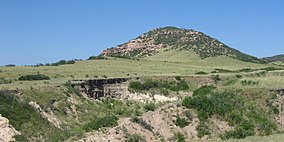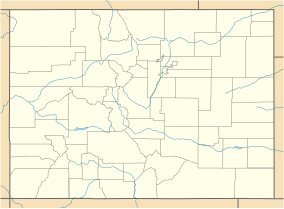Soapstone Prairie Natural Area
| Soapstone Prairie Natural Area | |
|---|---|
 The arroyo surrounding the Lindenmeier archaeological site (Folsom culture) on Soapstone Prairie Natural Area near Fort Collins, Colorado. | |
 Map of Colorado | |
| Location | Larimer County, Colorado, United States |
| Nearest city | Fort Collins |
| Coordinates | 40°58′48″N 105°03′44″W / 40.979898°N 105.062256°WCoordinates: 40°58′48″N 105°03′44″W / 40.979898°N 105.062256°W |
| Area | 28 sq mi (73 km2) |
| Established | 2004 |
| Official website | |
Soapstone Prairie Natural Area is a 28-square-mile (73 km2) park and conservation area in northeastern Larimer County, Colorado, United States. The City of Fort Collins purchased the land for Soapstone Prairie Natural Area in 2004, which was opened to the public in 2009.[1]
Ecology[]
The natural habitat of eastern Colorado was shortgrass prairie. Over the past 150 years much of the land was used for agriculture. Of the 40% of the remaining shortgrass prairie, much of it is degraded and fragmented due to neighboring cities, towns and farms.[2] Almost 60 endangered black-footed ferrets were reintroduced in 2014.[3] The Natural Resources Department of Larimer County recognized that grazing was important for soil, vegetation and overall ecological balance and that Bison were the primary historical grazers before being extirpated. The managers wanted to create a herd that could act as a seed herd that would help establish bison with heritage genetics.[4] Establishing a conservation Herd became a collaborative effort of Larimer County, the City of Fort Collins, the US Department of Agriculture’s Animal and Plant Health Inspection Service, and Colorado State University.[5] Yellowstone genetically pure bison were introduced in 2015 onto the contiguous lands of Soapstone Prairie Natural Area and Red Mountain Open Space.[6] Ten bison were released into a 1,000-acre (400 ha) fenced site.[7]
Archaeological site[]
The Lindenmeier Site, named for the previous Lindenmeier Ranch, is a Folsom archaeological site on the Soapstone Prairie Natural Area. The site contains the most extensive Folsom culture campsite yet found with an uncorrected averaged radiocarbon date of 10,660±60 B.P., or 8,710 B.C. The site was declared a National Historic Landmark on January 20, 1961.[8]
See also[]
References[]
- ^ "Soapstone Prairie Natural Area". City of Fort Collins. 1996–2011. Retrieved 2011-09-19.
- ^ "Trails of Northern Colorado: Exploring Cultural and Natural Heritage". Fort Collins Museum & Discovery Science Center. 2010. Retrieved 2011-09-19.
- ^ Meyers, Stephen (October 14, 2015). "Soapstone Prairie offers remote, beautiful experience". The Coloradoan. Retrieved 2021-02-16.
- ^ Boster, Seth (February 15, 2021). "From Colorado prairie, heritage bison slowly returning to native lands". Colorado Springs Gazette. Retrieved 2021-02-16.
- ^ "Laramie Foothills Bison Conservation Herd Project". Colorado State University. Retrieved 2021-12-02.
- ^ Marmaduke, Jacy (November 7, 2015). "Rare bison free to roam in northern Colorado". Durango Herald. Retrieved 2021-05-16.
- ^ Zaffos, Joshua (2016-04-04). "In bison recovery, scientists start small". High Country News. Retrieved 2021-05-16.
- ^ "Lindenmeier Site". National Historic Landmark summary listing. National Park Service. Archived from the original on 2008-01-04. Retrieved 2007-10-15.
External links[]
- www
.fcgov Soapstone Prairie Natural Area.com /naturalareas /finder /soapstone - Laramie Foothills Bison Conservation Herd
- City of Fort Collins: Soapstone Prairie Management Plan
- Trails of Northern Colorado: exploring cultural and natural heritage
- Museo de las Tres Colonias
- Cathy Fromme Prairie Natural Area, Fort Collins
- Protected areas of Larimer County, Colorado
- Protected areas established in 2004
- 2004 establishments in Colorado
